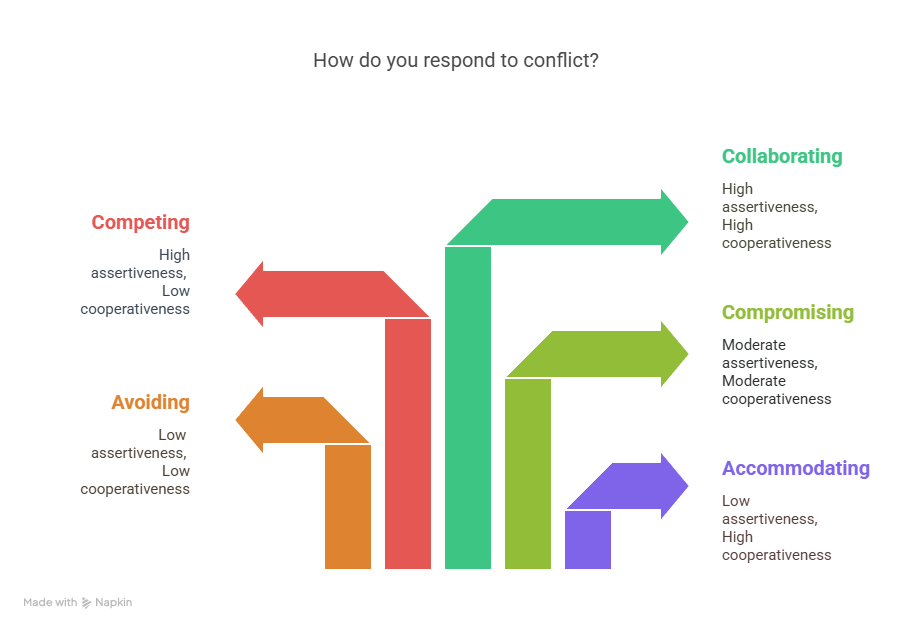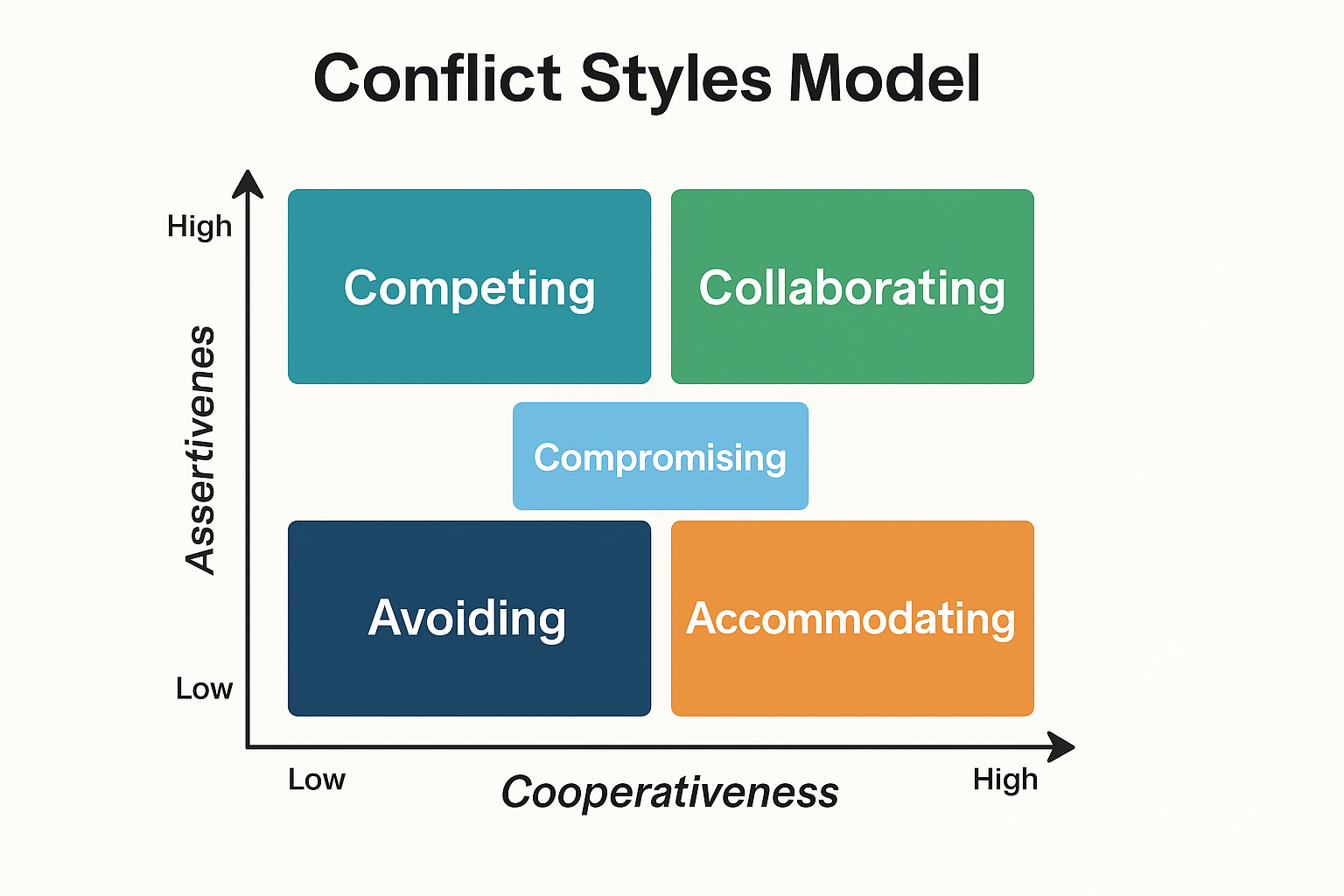Understanding Conflict Styles: A Key Tool in Mediation

“The more we understand how we respond to conflict, the better equipped we are to resolve it.”
Joanne Law
The Conflict Styles model is one of the most valuable tools I use with clients—especially during the pre-mediation phase.
Sometimes I do it verbally, “It seems like you tend to avoid conflict. How do you think you will go about speaking up about your perspective on the issues?” Sometimes I am more direct, showing them the model.
Either way, it helps people reflect on their own responses to conflict and opens the door to better communication, understanding, and collaboration.
What Is the Conflict Styles Model?
This model is based on the work of Kenneth Thomas and Ralph Kilmann, who developed the Thomas-Kilmann Conflict Mode Instrument (TKI)
It considers how people typically respond to conflict, based on two dimensions:
- Assertiveness – the degree to which they advocate for their own needs
- Cooperativeness – the degree to which they consider the needs of the other person
Want to dive deeper? The Kilmann Diagnostics Mission | Resolving Conflict & Managing Change
The five styles are:
Competing
Avoiding
Accommodating
Compromising
Collaborating

How you can use the Conflict Styles Model in Mediation
Very briefly this is how I make use of this knowledge.
1. Competing (High Assertiveness, Low Cooperativeness)
Description:
This person pursues their own needs at the expense of others. They often take a win-lose approach and may come across as forceful or controlling.
Mediator’s Role:
Help them recognize the limitations of one-sided outcomes in mediation.
Reframe success as a mutual solution, not domination.
Encourage active listening and empathy to shift from positional bargaining to interest-based dialogue.
2. Avoiding (Low Assertiveness, Low Cooperativeness)
Description:
They sidestep conflict, hoping it will go away or resolve itself. May struggle with confrontation or feel overwhelmed.
Mediator’s Role:
Create a safe, low-pressure environment to ease their anxiety.
Use gentle prompts to draw out their concerns and validate their feelings.
Emphasize that mediation offers a structured, supported space—not confrontation.
3. Accommodating (Low Assertiveness, High Cooperativeness)
Description:
These individuals prioritize others’ needs over their own, often at a personal cost. They want harmony but may sacrifice fairness.
Mediator’s Role:
Encourage them to voice their own needs and not just agree for peace.
Reinforce that compromise does not require self-sacrifice.
Balance power by validating their concerns and ensuring they’re truly heard.
4. Compromising (Moderate Assertiveness, Moderate Cooperativeness)
Description:
They aim for middle ground—each party gives a little. It’s pragmatic but may lead to superficial solutions.
Mediator’s Role:
Acknowledge their desire to move forward, but explore deeper needs beyond the quick fix.
Help both sides identify what matters most so they don’t trade off on important values.
Push gently toward collaboration if possible, not just split-the-difference.
5. Collaborating (High Assertiveness, High Cooperativeness)
Description:
They seek win-win outcomes by integrating both parties’ needs. Ideal in mediation but can be idealistic or time-consuming.
Mediator’s Role:
Support and reinforce this style—it aligns with mediation goals.
Help manage expectations and stay grounded in realistic outcomes.
Facilitate open dialogue to uncover shared interests and long-term solutions.
🎯 Summary Table
| Conflict Style | Key Trait | Mediator’s Support Strategy |
|---|---|---|
| Competing | Assertive, uncooperative | Redirect to mutual gain, soften positional stance |
| Avoiding | Withdrawn, conflict-averse | Build safety, encourage expression, validate softly |
| Accommodating | Overly giving, peace-seeking | Empower self-advocacy, balance needs |
| Compromising | Quick to settle, pragmatic | Uncover deeper needs, explore collaborative options |
| Collaborating | Win-win focus, open-minded | Foster creativity, manage expectations |
When I conducted mostly face-to-face mediations, I’d carry a printed version or sketch it out on paper. Now, I share it on-screen or send it ahead of time.
During pre-mediation, I explain:
“In mediation, our goal is collaboration. My role is to create a space where you can both walk away with an agreement that reflects your true needs not just what you think you can get. But sometimes the approaches people have been using are counterproductive to their ability to achieve this. Can we have a look at this model for a moment to explore the way you’ve both been interacting in your conflict?”
To make the model more relatable, I often reframe the terminology:
Focus – What are you paying attention to?
Needs – Whose needs are you trying to meet?
This helps clients from all backgrounds better understand their own behaviours without feeling judged.
How It Prepares Clients
The more prepared a client is, the smoother the mediation process runs.
In workplace mediation, back-to-back sessions (pre-mediation in the morning, full session in the afternoon) are common—but not ideal. Clients often benefit from time to reflect and consult advisors.
In family law mediation, I ensure a gap between sessions so clients can:
Get legal advice
Talk to family/support people
Consider their realistic options
This ensures clients walk in ready to listen, express needs, and make informed decisions.
What Do People Really Want?
From years of experience, I’ve found that most people:
Want to be treated with respect
Want to be heard, not judged
Don’t want assumptions made about them
Prefer solutions that are fair, not forced
Simple ideas—but in conflict, they can be difficult to express.
The Conflict Styles model allows us to have these conversations without blame, shame, or defensiveness.
Addressing Power Imbalances
If a client is too afraid or is unused to expressing their needs, then mediation may not be appropriate, or safeguards may need to be put in place.
Likewise, when someone has significant power, they may fall into a positional bargaining mindset—believing they can control the outcome. Educating them about collaborative negotiation often shifts this dynamic for the better.
With understanding and preparation, both parties are more likely to feel safe, respected, and heard.
Want to Become a Professional Mediator?
At Mediation Institute, we offer nationally recognised training programs:
AMDRAS Certificate of Training – Flexible, 100% online
CHC81115 – Graduate Diploma of Family Dispute Resolution – For those interested in becoming a Family Law Mediator (accredited FDRP)
Not sure where to start? Contact us and we’ll guide you.
Are You a Mediator with a Model to Share?
Do you use a framework, diagram or technique in your mediations that helps clients understand conflict?
We’d love to feature your approach on our blog.
Contact us to discuss writing a guest post or presenting to our members. Contacts
Resources & Downloads
- Download the Article as a PDF
